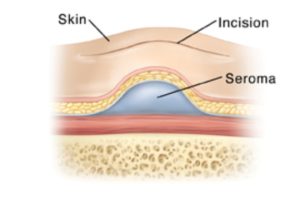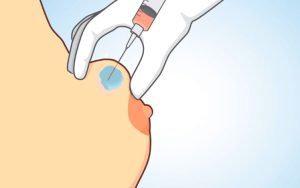Reviewed by Prof. Dr Fuat Yuksel.
Seroma is a complication that commonly develops after plastic surgery but fortunately, it’s not dangerous.
In fact, a small seroma can get reabsorbed by the body without needing any treatment.
However, if the size of the seroma is large and it’s increasing in size while becoming more painful for the patient, it needs to be treated in a clinical setting.
But before anything, many people don’t know what is a seroma and why it develops in the first place. So, let’s find out.
Understanding What Is A Seroma
National Health Institute (NIH) defines what is a seroma. According to it, a seroma is the accumulation of fluids (also called serous fluid) in the tissue, organ or cavity (empty space) in the body.

Seroma under the skin
It’s a clear fluid having a yellowish-white colour and can develop anywhere near the site of surgery. This fluid build-up shouldn’t alarm you as it is usually absorbed by the body.
However, it can take a few months to a year for the postoperative seroma formation to go away. Surgeons do recommend some treatments to patients who have seroma.
Whether or not you’re getting one, you need to observe the seroma to notice any changes in it. Unfortunately, the formation of seromas inevitably prolongs the recovery period.
It’s important to note that seroma formation is commonly associated with breast cancer surgery.
It can also develop as a result of other aesthetic or reconstructive surgery of the breast or other areas of the body (liposuction, tummy tuck).
To avoid the possibility of seroma formation after certain surgical procedures, the surgeons insert drainage tubes in the surgical areas following the surgery.
These may be enough to prevent such postoperative complications. However, sometimes, they still develop a few weeks after the surgical intervention.
Pictures of Seroma
To get a better idea of what a seroma actually looks like, here are a few pictures:



Causes of Seroma Formation
Although medical practitioners know what is a seroma, unfortunately, the causes of seroma formation aren’t exactly known.
However, there are some explanations as to why it may happen and certain risk factors that increase the chances of its development. First, let’s take a look at all the plausible causes of seroma after a surgical procedure.
Formation of Cavity or Empty Space
According to a study published in the Aesthetic Surgery Journal in 1998, seromas may develop as a result of “shearing forces.”
In this study, the researchers performed a tummy tuck, also known as abdominoplasty. According to them, the skin flap and underlying muscles in the abdomen were getting pushed in different directions after the surgery (and creating a dead space), which was causing a seroma.
To prevent that, they sutured the skin flap to the muscles, which did prevent its occurrence.
There’s an increased risk of seromas in surgeries that require the complete or partial removal of skin and tissue. Since the surgeons have to cut blood vessels and lymphatic vessels to get the tissue out, the fluids from them may seep into the empty space and fill up into a seroma.
According to the Cancer Treatment Centres of America (CTCA), this fluid comes from the lymphatic system or is a mixture of lymph and serum (blood plasma without clotting factors).
Inflammatory Response by the Body
It is also believed that seromas form as a result of the surgical trauma itself. The fluid builds up around the surgical area because of an inflammatory response by the body.
A randomized trial published in Plastic and Reconstructive Surgery showed the administration of anti-inflammatory medicines reduced seroma accumulation after surgery.
Risk Factors for Seroma Formation
Some risk factors for the formation of seromas after surgery have been identified. Having one or more of them increases the likelihood of you developing them. They are as follows:
- Hypertension or high blood pressure
- Old age (more than 45)
- Removal of a large amount of skin and fat and a large-sized surgical area
- Long surgical time
- High body mass index (BMI)
You must discuss these with your surgeon before the procedure so that you know what to expect afterwards.
Signs of Seroma
Seroma appears like a noticeable lump under the skin. It is swollen, sore, and squishy. It can develop days or weeks after surgery.
If the seroma is persistent and increasing in size, you might experience more pain and discomfort.
Knowing what is seroma, you need to keep an eye out for these signs.
When To Seek Immediate Medical Help?
Knowing what is a seroma, if you’re experiencing any of the following problems, you should seek immediate help:
- Discharge from the surgical area
- High fever
- Fast heartbeat
- Bleeding and pain
- Wound dehiscence (the reopening of the surgical incision)
These can damage the results of the surgery, which is why you must get help as soon as possible.
How To Help A Seroma Reabsorb?
It is possible for small seromas to be reabsorbed by the body, and there are some things you can do to help with that:
Apply Heat
Your doctor may recommend this in addition to medications. However, this only helps with small seromas.
Since they can take some time to get reabsorbed by the body, you can speed up the process by using a heating pad or warm compressor.
This can even help relieve the pain. Just make sure that you’re not applying too much heat to the area, as it can worsen the seroma.
It’s also important to note that you shouldn’t use compressors without your surgeon’s approval.
Wear Your Compression Garment
Many surgeons recommend their patients wear compression garments for a few weeks after the surgery.
It’s believed that it can help reduce the risk of seroma formation or prevent it.
According to a study published in Breast Cancer, the idea behind it is that compression garments can mechanically close the dead space underneath the skin.
Additionally, in a study published in the Journal of Reconstructive Microsurgery, the researchers suggested that compression garments might help by acting as barriers from shearing forces.
And while there isn’t enough evidence in support of compression garments, it’s still widely believed that they help. So, make sure to do as your surgeon advises.
Keep Your Skin Clean
You need to make sure that the skin around the seroma is clean so that it doesn’t get infected. If the seroma gets infected, there’s even a risk of abscess formation.
Before you touch the seroma, make sure that your hands are washed. If you’re applying heat, you need to apply a clean compress.
Also, don’t apply anything on your skin (like fragrant lotions) that can irritate it.
Treatment of Seromas
Understanding what is a seroma and what it looks like will help in its early identification so that you reach out to your doctor.
Other than a physical exam, the surgeon may perform an ultrasound or computerised tomography (CT) to get an accurate diagnosis.
After that, they will discuss different treatment options with you, depending on your case.
If the seroma is small, you may be given some medicines (like antibiotics) to avoid further complications.
The reason why doctors don’t treat small seromas with needle aspiration is that the very act of puncturing the skin with the needle can increase the risk of infection.
However, if it’s large and quite painful, you may need the following treatment:
Aspiration
For this, you’ll have to come to the clinic. The doctor will first give you local anaesthesia so that you don’t feel any pain or discomfort. A fine, thin needle is then inserted into the seroma to remove the fluid.

You may need to get this drained more than once a week for a few months.
While getting this treatment, you must keep the surgical area clean to avoid developing an infection.
Bear in mind seromas can form even after they’ve been drained.
Prevention of Seromas
The use of surgical drains is intended to prevent seromas altogether. However, other additional measures are also taken.
First and foremost, if you’re given a compression garment to wear after the surgery, wear those for as long as instructed by the surgeon (it’s usually around 4-6 weeks).
In addition, take the medicines that the doctor prescribes.
Other than that, restrict your physical activity after the surgery. Some studies do show that the movement of the shoulders after breast surgery increases the risk of seromas. So, you need to avoid that.
Lastly, make sure that you maintain good personal hygiene so that you don’t develop an infection. Understanding what is a seroma can help you prevent it from forming.
Potential Complications of a Seroma
If the size of the seroma is large and it is worsening by the day, you need to get help without any delay.
That’s because if left untreated, seromas can lead to long-term complications, which can directly impact your health.
To begin with, the continually stretched skin over a large seroma can sag, which can leave you dissatisfied after cosmetic surgery.
In addition, seromas can reduce blood supply to the surrounding tissues, which can cause permanent damage to them.
Left untreated, fibrous tissue can encapsulate seroma, hardening its surface and making it more difficult to drain the fluid.
Seromas can also get infected, which can even lead to the formation of an abscess. They can also calcify the surrounding tissue, which can remain even after the body reabsorbs the fluid.
So, make sure to get treated for these. Note that these calcifications can end up showing on your mammograms.
Conclusion
Knowledge of what is a seroma and what it looks like can help you in its identification so that you can get early treatment for it. For that reason, it’s important that you keep an eye out for their signs.
Simply, it is an accumulation of fluid in the area around where the surgery took place. Seromas are not harmful and, usually, they go away on their own.
However, in some cases, they need to be treated in a clinical setting by a doctor. This is usually the case with large-sized seromas that are causing pain and discomfort to the patient.
Seromas can develop soon after the surgery or after 1-2 weeks. If you notice that the size of your seroma is changing, you should get help as soon as possible.
That’s because if you leave them untreated, they can cause more problems for you and permanently damage the results of the surgery.
The exact cause for the formation of seroma isn’t known. However, few risk factors increase the likelihood of its development. Make sure to discuss these with the doctor before undergoing surgery.




